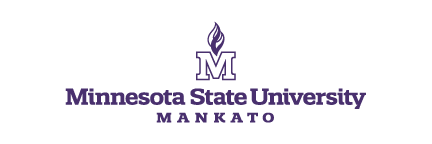Human Factors and Ergonomics Lab
Resources
Please visit the Human Factors & Ergonomics for video demonstrations on all topics covered in the MET 423/523 Ergonomics and Work Measurement courses.
Dr. Shaheen Ahmed is a Certified Professional Ergonomist (CPE), who manages the Human Factors and Ergonomics Laboratory and Research in the Department of Automotive and Manufacturing Engineering Technology at Minnesota State University, Mankato. Students are trained on a wide variety of topics in human factors and ergonomics, including
- Physical ergonomics
- Cognitive ergonomics
- Organizational ergonomics
- Macroergonomics
- Sociotechnical system
- Psychosocial workplace ergonomics
- Work physiology applying heart rate data
- Workstation design applying anthropometric principles
- Screening tools and methods (e.g. RULA, REBA, JSI, SOFI, Borg, etc.) in the Human Factors and Ergonomics to evaluate, develop, and redesign products, manufacturing processes, service processes, office works, work environments, workplace, and work-tasks
- Manual material handling including the NIOSH lifting equations, and Snook Table
- Motion and time study
Research Posters presented at conferences
Applied Ergonomics Conference, 2018, Atlanta, GA
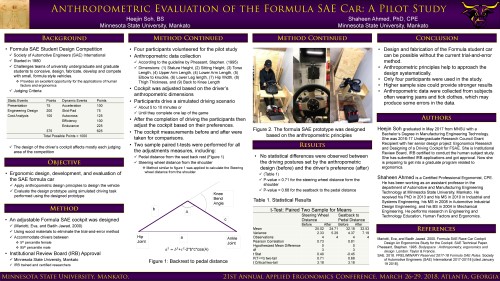
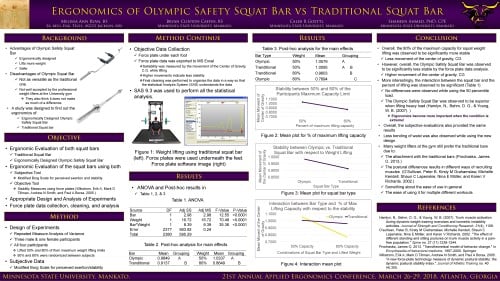
Applied Ergonomics Conference, 2019, New Orleans, LA
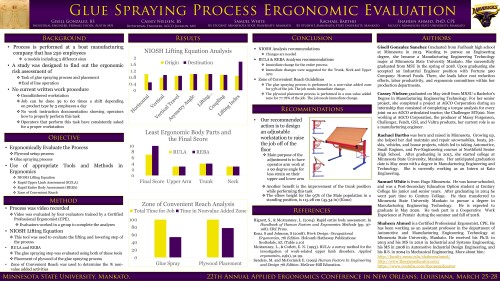 .
.
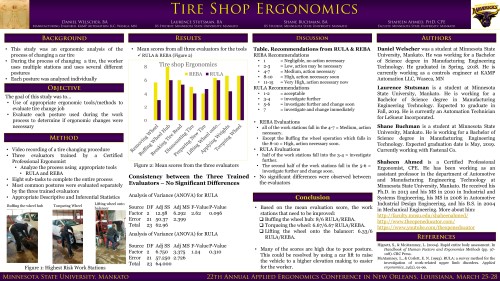
Lab Assignments and Associated Learning Outcomes
Learning Outcomes
After successfully completing this laboratory on work physiology, students will be able to assess the impact of the design a work/job on both subjective and objective human physiological capability.
- Students will be able to measure and interpret the following parameters to estimate the effect of work design on the human
- Rating of Perceived Exertion (RPE)
- Resting Heart Rate, HR
- Average task HR
- The maximum task HR
- Theoretical maximum HR (220 – Age)
- The percentage of maximum aerobic capacity for a particular work-task
- Calorie consumption using HR for various work-tasks
- The percentage of maximum aerobic capacity (PMAC) for various types of work-tasks
- The PMAC during an 8-hour work shift for various types of work-tasks
- The physiological fatigue level towards the end of an 8-hour shift for various types of work-tasks
- The peak percentage of maximum aerobic capacity for various types of work-tasks.
- Apply RPE in work design
- Compare and contrast RPE between team members, eventually apply the RPE in job/ work-task design, develop, and evaluation
- Apply the human physiological capacity in work design
- Compare and contrast physiological capability between team members, eventually apply the knowledge in job/work-task design, develop, and evaluation
Learning Outcomes
After successfully completing the lab assignments on the anthropometric design principles, students will be able to,
- Define and interpret the anthropometric nomenclatures
- Demonstrate the method/principle of the anthropometric data collection procedures
- Estimate the population percentile based on stature height
- Estimate the population percentile based on body weight
- Measure human anthropometric dimensions properly, including
- Sitting dimensions
- Standing dimensions
- Functional dimensions
- Estimate/measure the population percentile for each anthropometric dimension
- Compare and contrast between team members, and the standard population percentile
- Calculate/Estimate dimensions for complex body positions
- Apply the workstation design principles
- Determine the appropriate body dimensions for the design
- Determine the appropriate user population of the workstation
- Determine the appropriate population percentile
- Determine the appropriate dimensions from the anthropometric table
- Convert the dimension using the statistical principle to the appropriate population percentile
- Consider the clothing adjustment for the design
- Measure dimensions of a workstation
- Compare the existing design dimensions and the new measurements calculated using the anthropometric principles
- Suggest practical changes based on the calculations
- Calculate the cost and benefit of the changes if the new design is implemented
- Appreciate human diversity by comparing and contrasting the anthropometric dimensions with standard values and with team members
- Design, redesign, develop, and evaluate workstation utilizing the anthropometric design principles
Learning Outcomes
After successfully completing this lab assignment, students will be able to apply tools/techniques/methods/principles in human factors and ergonomics, including but not limited to,
- Rapid Entire Body Assessment (REBA)
- Rapid Upper Body Assessment (RULA)
- Job Strain Index (JSI)
- Snook Table
- Rating of Perceived Exertion (RPE) Borg Scale
- Swedish Occupational Fatigue Inventory (SOFI)
- Collect appropriate data for each of the tool/method used
- Clean the data according to the requirements for the tool/method used
- Analyze the products/workstations/work-tasks/processes assigned using the most appropriate tool
- Make redesign recommendations based on the tool/method used for the evaluation
- Perform statistical analyses when appropriate
- Descriptive Statistics
- Inferential Statistics
The Ahmed’s List of Tools in Human Factors & Ergonomics
- A list of 186 currently used tools/methods (last updated in 2017) in human factors and ergonomics can be found in TheOpenEducator.com
- Step-by-step training videos on how to use these tools/methods can be found at the www.TheOpenEducator.com or www.YouTube.com/TheOpenEducator
Learning Outcomes
After successfully completing this lab assignment, students will be able to use and apply NIOSH lifting equation for both single and multi-tasks lifting. A few objectives for the NIOSH lifting equations are provided below.
- Measure horizontal locations (H)
- Measure vertical locations (V)
- Measure average weights lifted for each task
- Measure maximum weights lifted for each task
- Measure lifting frequency rates for each task
- Measure lifting duration for the job
- Measure coupling quality of the handle
- Compute the Recommended Weight Limit for each task
- Compute the frequency-independent-RWL (FIRWL)
- Compute the frequency-independent-lifting index (FILI)
- Compute the single-task-RWL (STRWL)
- Compute Single-task-lifting index (STLI) for each task
- Compute the lifting Index
- Make redesign recommendations based on the analyses
Learning Outcomes
After successfully completing this lab assignment, student will be able to perform motion and time study to measure work/job. A few learning objectives of motion and time study include.
- List the appropriate elements of work to be studied
- Communicate with the worker to verify the elements of the job
- Measure the time using stop watch/video recording
- Compute the mean and standard deviation
- Determine the appropriate sample size
- Determine the normal time
- Determine the standard time
- Determine standard cost
- Determine the number of machines/operators
- Determine the cycle time
- Determine the completion time
- Determine the value and non-value added motion
- Determine the appropriate sampling technique (e.g. random, convenience)
- Include the necessary allowances, foreign elements, etc.
- Apply the predetermined motion time systems (PMTS)
- Apply the Methods-Times Measurement 1 (MTM-1)
- Apply the Methods-Times Measurement 1 (MTM-1)
- Apply the learning curve on the motion and time study
- Define the MOST work measurement system
- Define the MODAPTS
Projects
Students are also required to successfully complete two applied ergonomic research projects, preferably with local industries or on the Formula SAE student car cock-pit design. Finally, the student work is then sent for publication as an abstract/poster in a conference, especially in Applied Ergonomics Conference in the spring each year.
Project #1. Bad Design Project
- Students have to come up with at least a couple of bad designs from the things they encountered in everyday life
- They will have to find the cheapest (low or no-cost) solution to the problems
- Finally, they will have to find a solution where budget is not an issue
Project #2. Industry Project/FSAE student car project
- Find a human factors and ergonomic issue in their workplace
- Check the scope and feasibility of the projects with the Instructor
- Apply the most appropriate Tool/Method/principle to solve the ergonomics issue(s)
- Make necessary redesign recommendations
- Fabricate the redesign solutions if it is within the scope of a class project
- Make a poster of 56”X31.5”
- Students must follow the guidelines by the Applied Ergonomics Conference
- Write the Abstracts for the Applied Ergonomics Conference in the next spring
- Student must follow the guidelines by the conference
Vehicle Ergonomics Research
Applied research on the vehicle ergonomics of the Formula SAE student car is also performed at the Department of Automotive and Manufacturing Engineering. Due to the size and shape of the FSAE car, it makes a great ergonomics project for teaching and learning. Each year team, they start with a flexible adjustable cock-pit, make their own design from scratch.
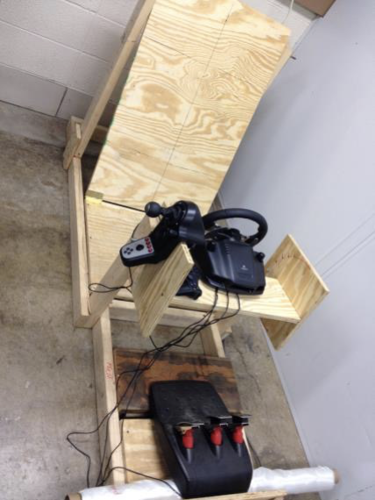
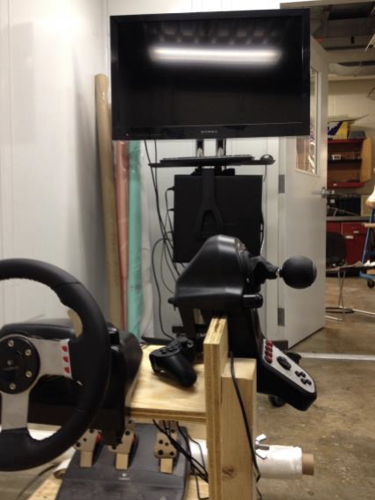
Training Provided to the Local Industries
Training to the local industries is also provided by the Human Factors and Ergonomics laboratory. Please contact the director of the continuing and professional education to discuss the opportunity for a training. The training cost could be covered by the State of Minnesota grants.
Continuing & Professional Education
Office: 424 North Riverfront Drive, Suite 101
Email: louise.dickmeyer@mnsu.edu
Phone: 507-389-3283
Publication from the lab/Research
- Buckley, M., Holmes, I., Larson, A. & Ahmed, S. (2020) Ergonomics of Lifting a 500-Pound Object Manually and Safely. 23rd Annual Applied Ergonomics Conference in Louisville, Kentucky, March 16-19. [accepted, conference postponed]
- Tasler, C., Ortiz, F., Rickleff, L., & Ahmed, S. (2020) Ergonomics of Hydraulic Insertion Press Job Evaluated and Redesign. 23rd Annual Applied Ergonomics Conference in Louisville, Kentucky, March 16-19. [accepted, conference postponed]
- Welscher, D., Stutsman, L., Buchman, S. & Ahmed, S. (2019) Tire Shop Ergonomics. 22th Annual Applied Ergonomics Conference in New Orleans, Louisiana, March 25-28.
- Sanchez, G., G., Nielsen, C., Bartho, R., White, S., & Ahmed, S. (2019) Evaluation and Redesign of the Glue Spraying Process for Boat Manufacturing. 22th Annual Applied Ergonomics Conference in New Orleans, Louisiana, March 25-28.
- Hee Jin, S. & Ahmed, S. (2018) Anthropometric Evaluation of the Formula SAE Car: A pilot study. 21th Annual Applied Ergonomics Conference in Atlanta, Georgia, March 26-29.
- Antolak, J. Paulson, P, & Ahmed, S. (2018) Ski/Snowboard Tech Shop Ergonomics. 21th Annual Applied Ergonomics Conference in Atlanta, Georgia, March 26-29.
- Ryan, M., Caffin, B., Goettl, C., & Ahmed, S. (2018) Ergonomics vs Traditional Squat Bar: A pilot study. 21th Annual Applied Ergonomics Conference in Atlanta, Georgia, March 26-29.

